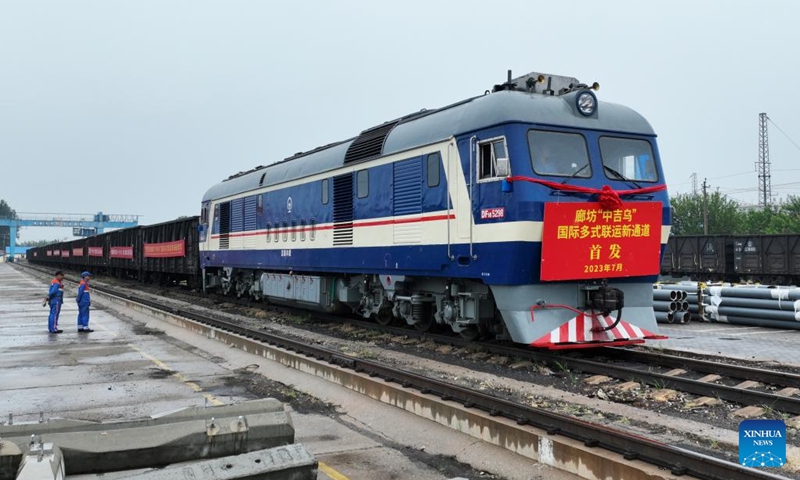Elvira Kadyrova
China continues to enhance connectivity with Central Asia by paving new transport channels to propel its flagship Belt and Road initiative.
More recently, containers were sent for the first time from the eastern province of Hebei to Uzbekistan via a multimodal route, and the southeastern Shenzhen city, the largest export center of China, is launching TIR transportation to Kazakhstan.
Route through Kyrgyzstan provides the shortest way to deliver goods from China to Uzbekistan
The new China-Kyrgyzstan-Uzbekistan rail and road transport route will expand international logistics from the Beijing-Tianjin-Hebei region to final destinations in Uzbekistan.
The length of the route from the Hebei’s Langfang city to Tashkent and Andijan is 6000 km, the travel time is 12 days.
“This new multimodal route is the shortest route for cargo delivery to Uzbekistan. Through Uzbekistan, it will be possible to deliver goods to South Asia, Turkmenistan, Azerbaijan and further to European countries, through Turkey it will be possible to ship. This corridor, we think, will help in every possible way in the development of our trade and economic relations and the rapprochement of our peoples. We think this is a very positive impulse for our relations,” said Abdumalik Kamilianov, General Director of the railway container company from Uzbekistan.
According to Yan Hailu, Deputy General Director of the China CAMC Engineering Corporation, this multimodal transport channel will significantly reduce the time and increase the safety of cargo transportation, greatly facilitating the development of trade between China and Central Asian countries.
Multimodal freight trains with thousands of tons of Chinese products also went to Uzbekistan from another significant economic center – Guangdong-Hong Kong-Macao Greater Bay Area.
The container multimodal transport system “railway-automobile” is used on the new route. After arriving in the Xinjiang Uygur Autonomous Region in northwest China, the containers will be reloaded from rail to road transport, then the cargo will proceed through the Irkeshtam checkpoint to Kyrgyzstan and onward to Uzbekistan, the Chinese media group CMG reports.
According to the report, compared to traditional routes, the new line saves almost five days on the way, providing a more efficient and accelerated logistics channel for trade between China and Central Asian countries.
“[These routes] have offered new choices for customers who could make delivery arrangements based on their particular needs, Dylan Feng, a sales executive of Austrian logistical company Gebrüder Weiss’ Chinese branch located in Ningbo, East China’s Zhejiang Province, told the Global Times on Tuesday.
Zhu Yongbiao, executive director of the Research Center for the Belt and Road at Lanzhou University, speaking about the route linking the Greater Bay area, commented that the launch of the new connection is of great strategic importance as it crosses the colossal Chinese market and links China’s two economic hubs with Central Asia.
The expert is confident that the acceleration of trade and economic exchanges will stimulate the implementation of the China-Kyrgyzstan-Uzbekistan railway project, the construction of which is expected to start this year.
In his opinion, there is huge potential for the development of the CKU Railway as it will have better transportation capacity and efficiency than road transportation.
In addition, this corridor will become the shortest route for the transportation of goods from China to Europe and the Middle East, reducing the journey by 900 kilometers and saving from seven to eight days on the way.
The TIR route expands the possibilities of connectivity between China and Central Asia
The global TIR transit system has connected China’s major manufacturing hub in Shenzhen with the largest city in Kazakhstan, the IRU reports.
Sinotrans, China’s largest integrated logistics company, has launched a new 5,200-kilometer TIR route between the Chinese city of Shenzhen and Kazakhstan’s Almaty.
Thanks to the opening of the TIR in Shenzhen, border transit procedures have been further simplified, which has reduced transit time and transport costs.
According to IRU Director of TIR and Transit Tatiana Rey-Bellet, the launch of this new route provides a direct trade route connecting Shenzhen, a key manufacturing and international trade hub of China, with the growing Central Asian market.
Last month, a new trade TIR route has been activated within the China-Kazakhstan corridor from the city of Xi’an in northwestern China to the Kazakhstan’s Dostyk. The first transportation on this route was also carried out by Sinotrans with the support of the IRU.
Bilateral trade between China and Kazakhstan, Kyrgyzstan, Tajikistan, Turkmenistan and Uzbekistan reached a historic high in 2022, totaling US$ 70.2 billion, an increase of about 40% year-on-year.
Since the heads of state agreed to deepen transport and trade cooperation at the China-Central Asia summit in May, the TIR will play an important role in improving regional connectivity and economic growth to a new level, according to the IRU.
The TIR, the world’s only global transit system, has been officially applied in China since May 2018, contributing to speedy, safe and efficient transportation from East to West. Today, the TIR system connects China with more than 30 Eurasian countries and is considered a flexible and competitive logistics solution that simplifies trade procedures within these corridors, which are steadily growing.
***
At the SCO summit on Tuesday (just on that day, a freight train left Hebei Province for Uzbekistan), Chinese President Xi Jinping called on the member-countries, which includes four Central Asian countries, to enhance the connection of Belt and Road cooperation with development strategies of various countries and regional cooperation initiatives. He stressed the need to further promote trade and investment liberalization and facilitation, speed up the development of port infrastructure and regional and international logistic corridors, and ensure stable and smooth functioning of regional industrial and supply chains.
Thus, improved transport connectivity with its stable hard and soft infrastructure is the key to the prosperity of trade and economic relations between China and Central Asia. ///nCa, 6 July 2023 [photo credit – Xinhua]
#China, #Central_Asia, #connectivity, #transport, #logistics, #Kazakhstan, #Uzbekistan, #IRU, #TIR


